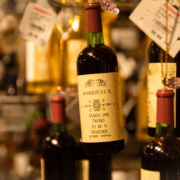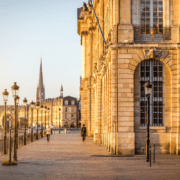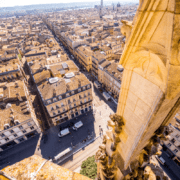
What to see in Saint Emilion?
Among the excursions to do from Bordeaux, we must say that a visit to this medieval village is practically a must. There are so many charms to see in Saint Emilion that we are sure that the free tour to Saint Emilion will delight you from beginning to end.
Is Saint Emilion worth visiting? Definitely, because it is surrounded by vineyards and tells a story that in many parts is mixed with legends and it is difficult to discover which is the real part. Here it seems that time has stopped and you can only breathe calm and the kindness of those who live there. They will always make you feel at home.
Saint Emilion: Origins, evolution and current events
In case you didn’t know, these lands produce some of the best wines in the world. In fact, there is evidence that by the time of the Romans, this area was famous precisely for its wines. However, as such, the town has its origins a little later, specifically in the Middle Ages.
According to the story, in the 8th century, a monk named Émilion who was traveling from Great Britain came to Ascumbas, a cave that was formed by the sea. The monk settled inside the cave and there he spent the last years of his life feeding the needy and, according to legends, performing miracles.
Around this cave, the community was established and eventually adopted the name of Saint-Émilion, in honor of the monk.
With the death of the monk, the ancient cave became a place of pilgrimage for the faithful who wanted to see the relics. This also helped it to be included in one of the routes of the Camino de Santiago. It also caused several religious congregations to establish themselves in the area, building monasteries and convents.
Between the 9th and 19th centuries, this locality was especially famous for being a producer of limestone. This was one of the most sought-after materials for the constructions of the time. In fact, what few people know is that in Saint-Emilion there are more than 200 km of subway galleries. Today they are used to store and preserve wine, as in the past.
In the 12th century, the Monolithic Church was built, one of the architectural jewels of the area and the most important religious building in the village. A century later, in the middle of the Middle Ages, the city walls were built, transforming Saint-Emilion even more.
Today, this beautiful enclave still maintains its original charm, besides being a powerful wine producer.
Why should you visit Saint Emilion?
Saint Emilion is not exactly a large town. On the contrary, it is quite small, compared to its neighbor Bordeaux. However, this does not detract from the fact that it is a unique and charming place where you will feel like you have traveled back in time, with narrow cobblestone streets that you can enjoy with the guide of Free Walking Tours Bordeaux.
Not to be missed in Saint Emilion
Don’t let its size fool you. It may not be a large metropolis, but there are many attractions that this town has to know and enjoy. Of course, always with a good glass of wine. Here is a small selection of the things you should not miss in Saint Emilion for any reason:
King’s Tower
In French it would be le Tour du Roy. As its name suggests, this is a huge tower built in the 13th century on one of the highest points of the city, right on the edge of the old city wall. This is the only Romanesque tower that remains intact in the city and was the seat of the local town hall until 1720.

Just at the foot of the tower is an old washhouse, one of the two that still remain in the city.
Nowadays it is possible to see the inside of the tower and even climb up to its beautiful terrace. From here you can get one of the best views of the city. The only detail is that you will have to climb 120 steps.
Logis de Malet
Being Saint Emilion on a hill, it is easy to distinguish how the city was divided in the past. The lower area was destined for the peasants, while in the upper part lived the noble and influential families.
In one of its highest areas, the Logis de Malet, one of the most famous buildings of the place, is located. It was built in the sixteenth century on the remains of an old mansion that had been erected in 1200.
The construction passed into the hands of the Malet de Roquefort family in the 18th century. They were in charge of some renovations and added stables, gardens, a wine cellar and a beautiful greenhouse. In 1879, the property passed to the public administration, converting it into a public school.
Saint Emilion Collegiate Church
In the immediate vicinity of the Logis de Malet is one of the most famous buildings, the Collegiate Church of Saint Emilion. Belonging to the Augustinian order, it was built between the 12th and 15th centuries.
Its original construction was inspired by the Romanesque style, of which large parts still remain, such as its impressive facade. Inside you can also see many Gothic details. Here you can see beautiful murals, stained glass windows and the impressive organ of Gabriel Cavaillé – Coll.
The municipal tourist office is located here. In addition, you can visit the old cloister with an impressive central garden which, according to experts, represents the garden of Eden.
Clocher Square
In front of the tourist office is the Place du Clocher, in English the square of the bell tower. As the name suggests, this is a bell tower that serves the impressive monolithic church. You can climb up to the upper balcony after stepping 196 steps, although the views are well worth it.
The bell tower is 68 meters high. It was built between the 12th and 13th centuries. The staircase was added in the 15th century.
Monolithic Church
Excavated in the same stone, this is the largest monolithic church in Europe. It is also the most important architectural jewel of the city.
Although its facade may seem a bit austere or simple, with only three Gothic windows facing the street, inside are the real beauties. We highlight the three naves that compose it, with 20 meters wide and 38 meters long.
This temple was excavated from top to bottom, between the twelfth and fifteenth centuries, with several large pillars that support the building. With the passage of time, it has been necessary to reinforce them, due to the weight of the bell tower, which is located just above.
You can visit it with a guided tour, which will also take you to the cave of Saint Emilion, where the monk retired and where he lived for 17 years.
Porte de la Cadene
Together with the Maison de la Cadene, they are the last building that maintains the traditional half-timbering of the village. Its facade dates from the 16th century, although its foundations are much older.
It is believed that the arch of the building served as a division for the time. The upper part was for the nobles and influential, while the lower parts were for the peasants.
Cloitre des cordeliers
The Cloitre des Cordeliers is located on Rue de la Porte Brunet, the Cloitre des Cordeliers. It is so called because of the rope or belt they always wore tied around their waists. These monks arrived in the town at the beginning of the 13th century, being this the second monastery they built at the end of the 14th century.
It consisted of the cloister, the church, the cellar, the garden, the courtyard and the main or administrative building.
During the French Revolution, the religious were expelled and the convent passed into the hands of the state in 1791. One of the most famous restaurants in Saint Emilion is located right here. You can also visit the interior of the building.
Salle des Dominicains
There are many religious buildings in Saint Emilion and the Salle des Dominicains is one of them. It is a former Jacobin convent, which currently houses one of the most famous exhibition halls in the city.
It stands out for its high ceilings, where the pointed arches are the protagonists. In addition, it has a beautiful stained glass window that gives it a wonderful natural lighting.
Palais Cardinal
The Palais Cardinal is one of the most famous and beautiful ruins of Saint Emilion. It was the residence of Cardinal Gaillard de la Mothe, nephew of the Archbishop of Bordeaux, Bertrand de Goth, who eventually became Pope Clement V.
It was built in the 12th century and although it is in ruins, some Romanesque style details can still be seen.
Vineyards
Hiking through the vineyards should be one of the must-do activities on this and any visit.. Especially if you cycle through them, a true tradition in Saint Emilion.
In total, the town has just over 5,400 hectares of vineyards, with 970 producers and four appellations of origin. This gives you an idea of what you will find.
How to get to Saint Emilion
Saint Emilion is located in the Nouvelle Aquitaine region, very close to the beautiful Bordeaux, but also to Navarre and the Basque Country. From Bordeaux it is only 40 km away, so if you are passing through the area, you can not miss it. Here the natural landscape is predominant, where the vineyards will always be the protagonists.
Where to sleep in Saint Emilion?
The sleeping options, although few, are not exactly bad. Here you can choose from accommodations for all tastes and budgets: From luxurious villas on the outskirts or apartments in the center a little simpler.
As for hotels and inns, there are also alternatives, especially towards the vineyard area. Besides being quiet, they are also much cheaper.
Also, being so close to Bordeaux, spending the day in Saint Emilion and going back to sleep will always be a good option.
Where to eat in Saint Emilion?
There are many options you can find to eat, of course always with the most impressive selection of local wine. In addition, zero kilometer and seasonal ingredients are the protagonists.
The food stands out for its homemade and traditional touch, with options for all tastes, including those with special diets. In addition, some of the best French macarons are available here. In fact, this is the typical local sweet. The traditional recipe has been maintained here for decades, originally from the Ursuline nuns. It is very different from the bunting found in other parts of France.



